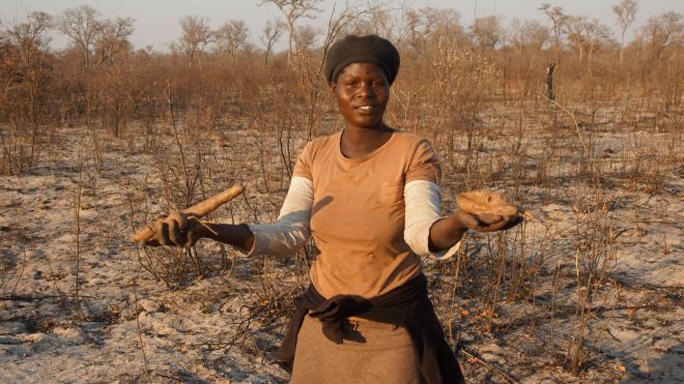Devil's Claw, Namibia. By Chris Kilham
At 4:30 a.m., the searing African sun has not yet set the dusty, drought-stricken Namibian countryside ablaze. Yet already, women from small villages of thatch huts are walking along the roadside with pots on their heads, making the trek to one of the scant few wells in the region. They’ll go miles for a few liters of water, and later in the morning, they will cook the corn gruel that is the staple food for native people here.
My friends and I peer into the fog that drifts across the dirt road we are traveling. It is not a fog of water mist, but of dust so fine that it drifts in small clouds across the landscape. During the day, that same dust will create a soft effect in the sky, muting the sun’s light but not its scorching heat.
By 5:00 a.m., we are in a village near the Angolan countryside. During the night we heard the braying of hippos near where we slept, but now our main concern is to avoid the puff adders and mambas, both highly toxic snakes, that slither around the sandy ground of this area. We are hundreds of miles from most modern conveniences, though several of the native people we meet have mobile phones. Our task is to hike out into the bush, to see the sustainable harvesting of the anti-arthritic herb “devil’s claw.”
Devil’s claw root is the common name for Harpogophytum procumbens, an herbaceous plant native to the Kalahari savanna of Southern Africa, the Namibian steppes, Angola and Botswana. Devil’s claw root refers to the dried tubers of the plant, which look like sweet potatoes and are used medicinally, primarily in Africa and Europe. Devil’s claw root plays a valuable role in African folk medicine, where it has been used as a digestive tonic, for blood disorders, to reduce fever, and as an analgesic.
Devil’s claw root has been well investigated in both animal and human studies. The root contains a group of compounds called the iridoid glucosides, which include harpagoside and are anti-inflammatory. It is primarily used to relieve the pain of osteoarthritis, with very good success.
A popular herb harvested in the wild, devil’s claw has drawn concern for its sustainability. Can the herb continue to be harvested at a rate of over 350 tons per year, or will the supply dry up? Nobody is cultivating devil’s claw at this point, as the culture of this anti-arthritic herb is very difficult. Our job, in the dawn out in the countryside, is to see how one group is harvesting the root sustainably, helping to keep the wild supply healthy.
We set off into the bush with a dozen harvesters at a very rapid pace, led by a tall, angular woman who would give Usain Bolt a run for his money. She moves like the wind, weaving in and out of the thorny shrubs that dot the entire area. We walk through seemingly endless piles of dried elephant dung, as this is wildlife country. There are lions, giraffes, hippos, elephants, buffalo, hyena, jackals, and innumerable other wild creatures out here. The day before a cheetah ran by near us. One harvester carries a long, plastic trumpet to ward off nearby elephants. I wonder if that trick will work.
After several miles, we arrive at an arid spot where several of the harvesters uncover shovels and digging instruments hidden in the sand under a tree. This area is where they will harvest today. They fan out, searching for the gnarled, tell-tale seed pots that indicate an underground devil’s claw plant.
Soon several of the harvesters are digging. The devil’s claw plant features a vertical “mother root” and has two opposing lines of tubers leading from that root, connected like sausage links. These harvesters leave the mother root alone, and only harvest one side of the tubers, leaving the mother root and the rest of the plant to regenerate. They will not harvest again in this spot for three years.
The harvesters accumulate small piles of tubers. These are mostly water, and the harvesters get paid by the kilo of dried root. They will have to lug their day’s catch back to the village in sacks, making a tough end to an already back-breaking day of digging. Ecoso, the company that buys from these people, pays twice what any other purchaser pays, so the money is better than what other devil’s claw harvesters are making. Many of the harvesters are women. Out here, if you can dig, you can earn a modest living. If you can do that, you can eat.
In the tough world of wild herbal harvesting, hard labor is the name of the game. Harvesting sustainably means that there will be a continued supply, and this means a future living. For those of us who may use devil’s claw to relieve arthritis, there are many people out far in the African bush, performing strenuous work to provide a remedy.


